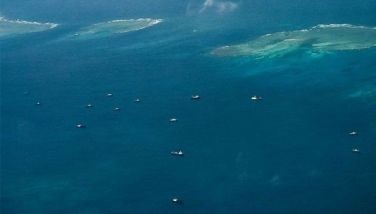Return of hard balancing in Philippine policy towards China's maritime expansion in South China Sea

During the second visit to Manila of U.S. Defense Secretary Lloyd Austin on February 2, Filipino and U.S. security officials announced that additional Philippine military facilities would host U.S. forces under the 2014 Enhanced Defense Cooperation Agreement (EDCA).
This announcement boosted the Biden administration's efforts to expand the American strategic footprint across the first island chain to counter China's aggressive moves against Taiwan.
The EDCA's new provision would add four more sites to the five Philippine military bases that American forces already use for training, pre-positioning equipment, taking-off and landing operations, and other functions.
On April 3, the Philippine government revealed the locations of the four new EDCA sites available for U.S. troop deployments in northern Luzon and Palawan, confirming their positions near Taiwan and the South China Sea. These locations would provide U.S. forces with a strategic vantage point from which they could mount rapid military operations in the event of an armed confrontation between the United States and China over Taiwan, which is more than 250 miles north of Luzon or the South China Sea.
Consequently, the Chinese embassy in Manila quickly opposed American strategic access to these Philippine bases. Chinese foreign minister and Politburo member Wang Yi warned President Ferdinand Marcos Jr. not to "lose the momentum" of his agreement with President Xi Jinping regarding the appropriate management of the South China Sea differences.
Along with his commitment to fund the third horizon of the Armed Forces of the Philippines’ (AFP) modernization program, President Ferdinand "Bongbong" Marcos Jr.'s decision to allow the United States to strengthen its strategic presence in the country marked the return of the Philippine policy of hard balancing towards China.
This is reminiscent of the late President Benigno Aquino III’s policy of hard balancing that challenged China's expansive maritime claim in the South China Sea.
In late 2016, however, former President Rodrigo Duterte reversed his predecessor's approach by adopting a policy of appeasement. In a conciliatory gesture, he extended two critical concessions to China—downgrading the Philippine-U.S. alliance and putting aside the July 12, 2016, arbitral ruling on the South China Sea dispute favorable to the Philippines.
After five years of implementing the appeasement policy, however, the Duterte administration shifted to "limited hard balancing" to constrain China's expansionist and revisionist agenda.
Specifically, this policy requires building up the Philippine military's external defense capabilities, maintaining its alliance with the United States, and making security arrangements with other middle powers like South Korea, Japan, and Australia.
From a balanced to hard balancing policy
At the onset of his six-year term, President Marcos planned a balanced foreign policy marked by efforts to promote economic cooperation with China while leveraging on this with closer security cooperation with the United States.
His game plan is to form a division of labor where China provides public investment for Philippine infrastructure development and the market of Philippine exports, with the United States extending the security umbrella.
The goal is to gain practical benefits from both the United States and China. It also aims to provide the Philippines with a strategic or diplomatic space between the two great powers through a calculated balance of power strategy.
This requires the Philippines to walk a fine line between fostering greater security cooperation with the United States while maintaining China's goodwill to keep the Chinese market open to Philippine exports and for Chinese public investment flowing to support the administration's “Build Better More" infrastructure development program.
Unfortunately, President Marcos's efforts to engage these two great powers in his diplomatic gambit of balancing one power against another do not suit China's long-term strategic goal of maritime expansion into the South China Sea.
To assert its sovereignty claims in the South China Sea, China must possess the means to control a maritime feature. It must maintain a persistent naval presence in the maritime vicinity to gain control.
China's maritime strategy requires the People's Liberation Army's Navy (PLAN), the Chinese Coast Guard (CCG), and the maritime militia to pressure foreign vessels in the disputed waters and force littoral countries, such as the Philippines, to abide by and accept Chinese jurisdiction and privileges in the South China Sea. China's uncompromising posture and coercive actions in the South China Sea, marked by the increase in the number of CCG patrols in the disputed waters, led to the frequent harassment of Philippine fishermen and Philippine Coast Guard (PCG) ships.
In 2024, the Philippines must expect that the region's security landscape will continue to expand and include more complex challenges. In an increasingly multipolar region, promoting a hard-balancing policy will allow the Philippines to steer the course of its foreign and security strategy. As a middle power, it should move from a small state narrative to one focused on active engagements with like-minded states.
The implication of the hard balancing towards China
These developments pushed the Marcos Jr. administration to hasten the modernization of the AFP, gravitate closer to the United States, and further enhance its security partnership with Japan.
These measures aim to balance or challenge Chinese maritime expansion in the South China Sea. In the first four months of 2023, Washington and Manila raised the level of their diplomatic activities, leading to a) the formal announcement of four new EDCA sites, b) the revival of the Two Plus Two Bilateral Security Dialogue, c) the holding of the largest Balikatan joint military exercise; d) the public release of the May 2023 Defense Security Guidelines that clarified under what conditions will the 1951 MDT could be invoked by each party; and e) the enhancement of interoperability between the two allies' armed forces through additional equipment transfers, training, and joint naval patrols.
President Marcos' hard balancing policy toward China is two-pronged. On the one hand, it involves an internal and external balancing strategy; on the other hand, it actively promotes economic and diplomatic cooperation with China. Like its predecessor, the Marcos administration still seeks a peaceful resolution to the West Philippines Sea dispute and the Taiwan Crisis.
The goals of the Marcos administration's strategy of hard balancing coupled with economic cooperation with China are aptly described by Filipino defense analyst Justin Baquisal as follows: "To raise U.S. stakes in committing to Philippine defense, improve the balance of forces in the region and even helps stem the growing perception by Chinese officials that the Philippines should effectively be neutral amid great power competition."
As a critical player in the region’s geopolitical game, the Philippines must enhance its middle power status to protect itself from another state’s expansionist ambitions. Furthermore, if implemented beyond a presidential term, a hard balancing strategy promises a future of a highly defended rules-based international order that benefits the Philippines and the international community. A return to an appeasement policy will not serve the Filipino interests.
- Latest





























